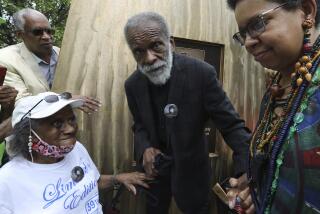From Tahrir Square to Ferguson, artist Glenn Kaino’s rocks of protest
Artist Glenn Kaino picked up his first rock in Cairo a couple of years back. He was in Egypt doing some research for the 13th annual Cairo Biennale, where he had been selected to represent the United States. Kaino’s meanderings around the ancient city eventually led him to Tahrir Square, the site of the historic protests that brought down the three-decades-long regime of Hosni Mubarak.
On the day he visited, the square was largely empty. But its status as a stage of political revolt resonated with the artist. Walking around it, his attention was eventually drawn to — of all things — a rock.
“I started to think about the rocks,” he recalls, “the fact that they can be street detritus but also have this political agency. They are this instrument of protest. Except they only have agency when they are thrown in the air. Once they fall to the ground, they become detritus again. It’s just a rock.”
Kaino picked up the rock and took it back to his hotel, where he packed it into his suitcase. The rock made the journey with him back home to Southern California, where he currently lives and where he is represented by Honor Fraser gallery in Culver City.
“I’m really interested in how one moment can come to encapsulate a city,” he says. “And that moment can then be encapsulated by other things.”
In this case, a rock.
The visit to Tahrir led Kaino to collect other rocks. On his own or through acquaintances, he has acquired rocks from sites of protest in places as far away as Syria, Yemen and Libya. Earlier this month, he was in Missouri to present a work at the World Chess Hall of Fame and used the opportunity to pay a visit to nearby Ferguson, where he met with protesters and mourners, and hung out with a young journalist who was covering the proceedings. He also collected a rock from the site. (By then the most violent confrontations, in the wake of a police shooting of an unarmed young black man, had already taken place.)
These protest rocks are now all part of an intricate sculpture that opened at the Kavi Gupta gallery in Chicago on Friday. Titled “Suspended Animation,” the work consists of an old industrial conveyor belt bearing all the rocks. Except there’s a trick to it: Kaino has balanced the conveyor on just two legs instead of the usual four, so that it appears as if the whole thing is about to teeter over. The only thing that keeps it in place is the weight of the rocks.
“If you remove those rocks,” says the artist. “That structure goes out of balance.”
The idea of balance is something that permeates the show. Another piece, a wall sculpture titled “Escala,” consists of a series of interconnected scales that have been carefully weighted so that the entire structure doesn’t lean or collapse.
“I was thinking about zero-sum games and balance,” Kaino says. “We live in a society where if one person wins, the other person has to lose. Victory always comes at someone else’s expense.”
Ultimately, Kaino says he sees the rocks as “tools, as instrument of protest.” And this is an idea that he plays with in various forms. In addition to the carefully cantilevered conveyor belt, the show also includes a pile of colorful 3-D printed plastic rocks — a way of stripping these tools of their more violent associations (and perhaps a way of making up for all of the rocks he has removed).
“By removing them,” he says, “I suppose I’m giving people one less tool to protest with.”
The work in many ways is also evocative of a moment that has come and gone. When Kaino collected that rock in Tahrir, it was a moment of political optimism in Egypt. One that, unfortunately, has since been overtaken by instability. As a result, the 13th Cairo Biennale, which Kaino had been preparing for, has been indefinitely postponed. Of the journey, he retains memories. And a rock that now sits in a gallery in Chicago.
“Glenn Kaino: Leviathan,” is on view at Kavi Gupta through Dec. 20, 219 N. Elizabeth St., Chicago, kavigupta.com.
Find me on Twitter @cmonstah.
More to Read
The biggest entertainment stories
Get our big stories about Hollywood, film, television, music, arts, culture and more right in your inbox as soon as they publish.
You may occasionally receive promotional content from the Los Angeles Times.







